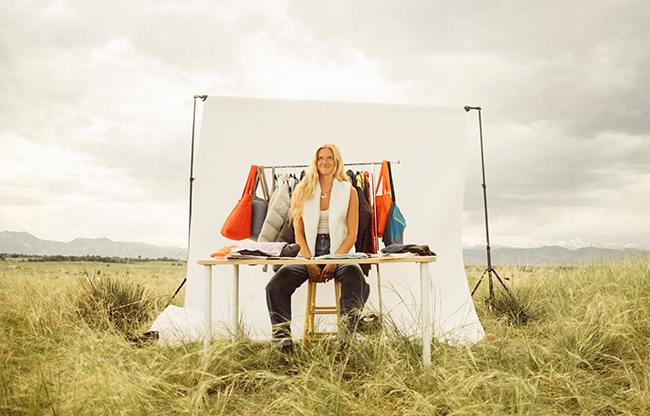Moose on the Loose
30 Aug 2014
Statuesque, aggressive animals put mountain dwellers on guard
By Kay Turnbaugh Ungainly but somehow still elegant, the barrel-chested moose with antlers three times as large as its head sauntered out of the woods and toward an Eldora garden where a wedding was scheduled in a few weeks’ time. The frantic father of the bride ran out of the house, waving wildly and yelling. Undeterred, the massive moose turned a baleful eye on the man and took a few more steps toward the wedding-perfect flowers. Afraid to get too close, the homeowner gave up with a disgusted sigh. Fortunately, this time the moose decided to move on without leveling the gardens. Moose were rarely seen in Colorado until they were “reintroduced” in 1978 and 1979, but the program to bring them to the state is “a real success story,” according to Jennifer Churchill of Colorado Parks and Wildlife. Since the first two-dozen animals were released in North Park, the moose population has exploded, reaching 2,300 in 2013. One reason for the boom is that moose have no natural predators in Colorado. A mountain lion may occasionally kill a moose calf, but only a grizzly bear or a wolf pack is capable of bringing down a full-grown moose. So the moose population keeps rising in Colorado. “They’re not at maximum capacity yet,” Churchill says. “We’re seeing tons of twins, and that’s a good sign that they are doing well.” The maximum carrying capacity is how many moose the habitat can support. Abundant forage can stimulate an above-average rate of twin births.A War for the Willows
Not everyone agrees that bringing moose to Colorado was a good idea. Local naturalist Dave Hallock says the literature indicates that until the late 1970s, moose were only occasional visitors to the state and had no documented breeding record. “The willow-shrub wetlands did not co-evolve with moose,” he points out. “But since willow is the staple food for moose, there is a real potential for conflict with other animals that utilize it for food and nesting sites.” One study in Grand Teton National Park, in northwestern Wyoming, found lower populations of neotropical mi-grant birds in areas with high moose populations. “I have noticed in willow-shrub wetlands that not only do moose eat the willows, but they also make pathways,” Hallock says. “A bird like the fox sparrow favors sizable, dense stands of willows for nesting. Moose tend to fragment the willow stand, disfavoring birds that require less-fragmented habitat.” Other naturalists believe there is also a potential conflict with white-tailed ptarmigan. “These birds feed on the tips and buds of willows as a winter staple. … They sometimes come down to as low as 8,000 feet during severe winters, increasing the potential for overlap with moose and competition for food,” Hallock explains. Since moose are solitary creatures that are difficult to spot in the woods, no one knows exactly how many are in Boulder County, but mountain residents can tell you they are seeing more moose every year. Moose are powerful swimmers, and have been spotted stroking across Nederland’s Barker Reservoir. Occasionally a moose wanders into the area’s larger cities—they’ve been seen in Longmont, Broomfield and Loveland. When that happens, wildlife officials hope the moose will leave town on its own, following the greenbelts back to less-populated areas. “We try not to tranquilize and move them, because that can kill them,” says CPW’s Churchill. That’s what happened to a young moose that was found trapped in Nederland’s skate park two years ago. Efforts to extricate the moose from the concrete bowls failed, and it later died from the stress of being tranquilized and moved.Danger at Your Doorstep
Tales of moose attacks on walkers and hikers are common in the mountains. Dogs are often part of the scenario, because moose associate them with predator wolves. Recently, two women hiking with their dogs in Gilpin County were attacked and spent time in the hospital. In 2006, Grand Lake Mayor Louis Heckert was repeatedly butted by an 800-pound bull moose as he walked to church; he died of head injuries. In 2010 a moose trampled a toddler in Grand County. A year ago, Katrina Harms, who lives off Magnolia Road, walked around the corner of her shed and encountered a cow moose with a calf. Harms was taking her two dogs for a walk, and Cheyenne, a 13-year-old, deaf Australian shepherd mix, ran toward the moose. The cow moose, protecting her calf, chased Cheyenne back to Harms, whose other dog ran to the house. Harms and Cheyenne ran behind a big tree, but the moose chased them to another tree before retreating 30 or 40 feet to continue eating. Harms and her dog held still for what felt like half an hour until the two moose ambled away. “We were lucky that we were near trees,” Harms says. “I think the mama moose just wanted to let me know that she wasn’t happy with me. I walked that same path for 14 years and never encountered a moose before, but now I watch for them. Having so many of them in the area has added an element of danger when you walk out the door.” Hikers are surprised by moose all the time, probably because the animals blend into the landscape and disperse widely to seek food. While moose are loners by nature, cows may travel and browse with a calf, and bulls sometimes wander in pairs. Rutting bull moose have charged horses, cars and locomotives. The female is particularly protective of her calf, and a normally slow-moving, easygoing cow can deliver a powerful kick with her hard, sharp hooves. After a hike a couple of months ago, John Thompson and his dog were charged by a moose that tried to run over his car to get to them. Thompson posted pictures of his damaged car and the moose on the door of his business in Nederland, the Mountain Man Outdoor Store, along with a warning to be careful around moose that comes from personal experience. If you want to see moose, look where there’s lots of brush for them to browse. Good viewing areas include Guanella Pass near Georgetown, Walden in North Park, and Brainard Lake in Boulder County, where they charm sightseers—those who haven’t been chased—by licking salt off cars in the parking lots. “They are very popular,” Churchill says, “and watchable—if you’re careful.”Nederland resident Kay Turnbaugh writes about a variety of subjects for Boulder Magazine. She is the author of Around Nederland, the award-winning The Last of the Wild West Cowgirls, and The Mountain Pine Beetle—Tiny but Mighty.












